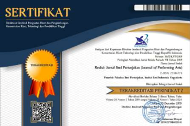Walt Disney’s Movie Soundtracks as Media in Developing Character Education for Children
Abstract
Keywords
Full Text:
PDFReferences
Ara, S. (2009). Use of Songs, Rhymes, and Games in Teaching English to Young Learners in Bangladesh. The Dhaka University Journal of Linguistics, 2(3), 168-169.
Ardipal. (2015). Kembalikan Lagu Anak-Anak Indonesia: Sebuah Analisis Struktur Musik. Panggung, 25(4), 345.
Arostiyani, D. (2013). Pemanfaatan Lagu Anak-Anak Sebagai Media Pendidikan Karakter di Taman Kanak-Kanak Aisyiyah Desa Linggapura Kecamatan Tonjong, Brebes. Semarang: Jurusan Sendratasik, Universitas Negeri Semarang.
Astuti, W. N. (2015). Pengaruh Pemberian Lagu Anak-Anak Terhadap Perilaku Prososial Siswa Taman Kanak-Kanak. Jurnal Empati, 4(4), 101 - 106.
Bhawono, P. L. (2012). Metode Pembelajaran Lagu Anak Pada Anak Usia Dini di SPS Pos PAUD Se Kecamatan Godean. Yogyakarta: Jurusan Pendidikan Seni Musik, Universitas Negeri Yogyakarta.
Engh, D. (2013). Why Use Music in English Language Learning? A Survey of the Literature. English Language Teaching, 6(2), 118.
Hurlock, E. (2006). Psikologi Perkembangan Suatu Pendekatan Sepanjang Rentang Kehidupan (Alih Bahasa: Istiwidayanti dan Soedjarwo. Jakarta: Erlangga.
Janjua, M. Z. (2016). Character Construction in Tribute Songs: Transitivity Analysis of the Song "I Am Malala". TRAMES, 20 (70/65), 2, 202.
King, S. L. (2005). The Benefits of Frequent Positive Affect: Does Happiness Lead to Success? Psychology Bulletin, 131(6), 845.
Laan, R. N. (2018). Helping Behaviour in Disney Animated Movies and Children's Helping Behaviour in the Netherlands. Journal of Children and Media, 12(2), 160.
Lal, K. (2013). Parent-Child Relationship among Boys and Girls at Secondary Level. American International Journal of Research in Humanities, Arts and Social Sciences, 4(2), 158.
Muthmainnah, L. (2017). Perancangan Kampanye Penanggulangan Dampak Lagu Dewasa Terhadap Anak-Anak. e-Proceeding of Art and Design, 4(2), 138.
Pala, A. (2011). The Need for Character Education. International Journal of Social Sciences and Humanity Studies, 3(2), 23-24.
Ransom, P. F. (2015). Message in the Music: Do Lyrics Influence Well-Being?. Pennsylvania: University of Pennsylvania.
Reeves, J. L. (2009). Building Character. London: Mixed Sources.
Rubio, I. M. (2015). The Use of Rhymes and Songs in the Teaching of English in Primary Education. Docencia e Investigacion, 25(2), 87.
Spellings, M. (2005). Helping Your Child Become a Responsible Citizen. Washington DC: Education Publications Centre, Department of Education.
Suyadi. (2013). Strategi Pembelajaran Pendidikan Karakter. Bandung: PT. Remaja Rosdakarya.
Tyasrinestu, F. (2014). Lirik Musikal pada Lagu Anak Berbahasa Indonesia. Resital Jurnal Seni Pertunjukan, 15(2), 163 - 164.
Ulutas, F. t. (2016). Using Storybooks as A Character Education Tools. Journal of Education and Practice, 7(15), 174.
DOI: https://doi.org/10.24821/resital.v19i1.2449
Refbacks
- There are currently no refbacks.
This work is licensed under a Creative Commons Attribution 4.0 International License.



